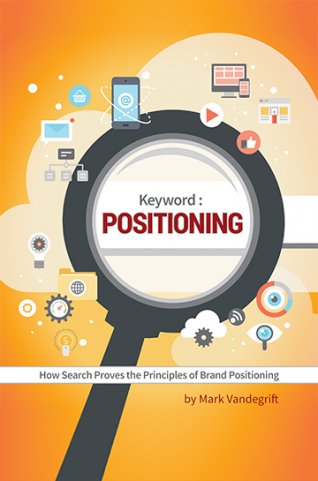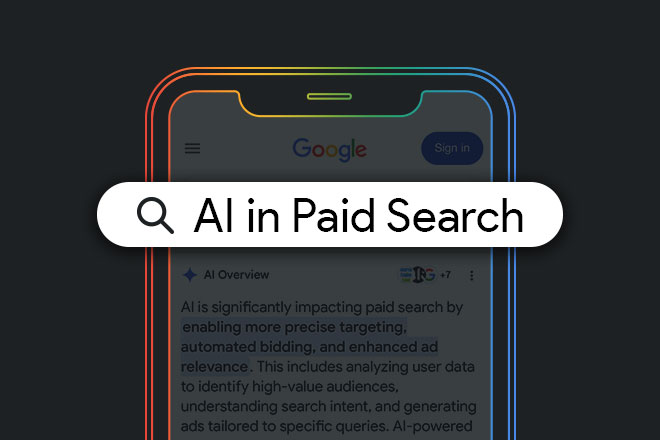AI in Paid Search Advancements on Google
With the airing of Google Marketing Live (GML) just a few weeks ago, marketers were updated on all the new features that will soon be coming to Google … and some that have already arrived. The common denominator across these new advancements? AI.
Google AI was officially announced in 2017, although AI and machine learning had been around for many years. It’s continued to evolve and grow and is becoming one of the — if not THE — top-used tools for marketers. Google is really steering the ship when it comes to how AI in paid search will be used moving forward, from how consumers will now see search ads, to how marketers can better optimize and measure search ads performance. AI will change the world of PPC. In fact, it’s already begun.
Where Will Consumers Start to Notice AI in Paid Search?
From a consumer perspective, AI continues to become more visible across various Google products, from AI-generated Overviews in organic search results to interactive features like Circle to Search. In some of the more recent updates, the AI Overview section is now being enhanced to include ads, allowing relevant search and shopping ads to appear directly within the AI-generated content based on a user’s search query. Google is also introducing AI Mode, its own take on a Large Language Model (LLM), like ChatGPT or Perplexity.
Ads in AI Overviews
With AI Overviews launching in 2024, Google successfully streamlined the search experience by delivering highly relevant content directly to users through its AI technology, front and center. However, this shift has posed challenges for advertisers, more so that users were either finding answers without clicking through to an advertiser’s website (thanks to the AI Overview section) or were only engaging with sites featured in the AI Overview section.
To help combat this, Search and Shopping Ads are now being integrated into AI Overviews, giving advertisers a better chance to reach users at the exact moment they’re most engaged in a highly visible and content-rich space. Since AI Overviews are designed to directly answer user questions, this integration could help advertisers capture a user’s attention right off the bat. Utilizing AI in paid search by including search ads in the AI Overviews helps ensure the ads remain visible and relevant in an environment where users are less likely to scroll further down the search results page.
Ads in AI Mode
In addition to introducing ads within AI Overviews, Google launched “AI Mode” towards the end of May 2025, its own conversational experience powered by an LLM, similar to platforms like ChatGPT and Perplexity. Since AI Mode is built and operated by Google, search ads will also be integrated into the user’s experience, appearing similarly to how they do on a traditional search engine results page (SERP).
Search ads will show if Google deems them as relevant to a user’s search query. This goes along with Google’s continued focus on relevancy as a key component to improving the search and user experience. However, there is a possibility that this could cause campaign performance problems, such as the following:
- Lower click-through rates due to users wanting to stay within the conversation and not wanting to click out
- Higher cost per click due to these being segmented as more premium placements, therefore, more competition
While Google is including ads in AI Mode, its strong focus on user efficiency may limit the effectiveness of this strategy for advertisers. The new format could impact campaign performance, potentially requiring a shift in approach.
Advertisers may need to consider a new approach in strategy when it comes to utilizing AI in paid search and shift their focus toward creating content that is engaging, relevant, and click-worthy, wrapping keywords in like a good high school thesis rather than pigeon-holing them where they don’t belong. Keywords will still play a big role, but the overall success of campaigns will depend on how well the content resonates with users in a more conversational, AI-driven environment. As of now, advertisers cannot request placements there, but Google states that those “who are already using Performance Max, Shopping and Search campaigns with broad match, including AI Max for Search campaigns, will be eligible to have their ads appear in AI Overviews and AI Mode.”
Enhancing AI in Paid Search Campaigns with Platform Upgrades
With all this talk of new advancements coming to AI in paid search, Google also made some enhancements to pre-existing components within its platform. Google reinvented what it’s now calling “The Power Pack,” which is the “next generation of AI-powered campaign solutions built for this new era of Search and multi-modal experiences.” (Google, 2025) Essentially, this is a new way to structure your campaigns within Google Ads, formatted to optimally perform given all the features and updates Google has made regarding AI.
Google states, “Power Pack is the engine that will drive next-level performance across Search and YouTube, using Performance Max, AI Max for Search campaigns, and Demand Gen.”
As we have begun implementing Performance Max campaigns alongside our search and Demand Gen campaigns, we have started to see an improvement in overall performance. We believe this will essentially give us fewer levers to pull in terms of manual optimizations, while in turn giving us more valuable data to make informed decisions when it comes to optimizing the overall performance of the campaigns. This allows advertisers to maintain control of campaigns, however, we are allowing the platform more of that freedom to go and gather valuable data needed to allow us to make those informed decisions. Overall, as we begin to utilize these upgrades of AI in paid search more and more, it will be interesting to see how it plays out in the market in terms of bidding auctions and overall competition.
How can marketers leverage AI in Paid Search?
There’s no doubt most advertisers will implement these features and updates. But the real question is, how can they be effectively leveraged to improve overall performance?
One of the biggest ways we can continue to leverage AI in paid search is by marketing to AI. Continuing to put out high-quality, relevant SEOd content is still going to play a massive role in this new AI landscape, as well as continuing to boost paid performance alongside it. AI in paid search is still going to require a human touch when implementing campaigns and optimizations, only now allowing advertisers even more data insights and tools to execute well-performing campaigns.
Innis Maggiore continues to stay up to date with the coming advancements and updates with AI in paid search. If you’d like to learn more about this topic or discuss how we can help you improve your digital campaigns’ performance, contact us today.



